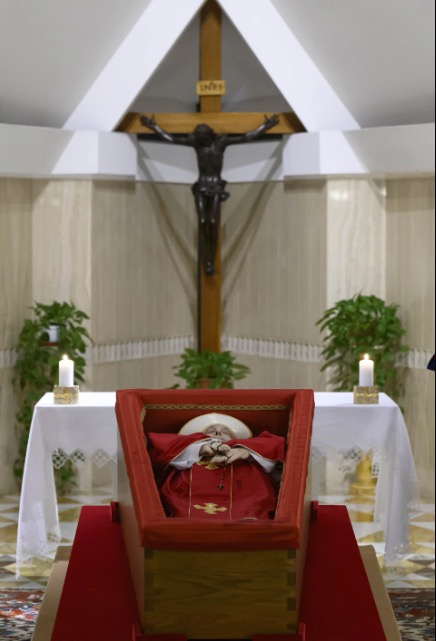
The images of Pope Francis lying peacefully in his coffin reveal much more than what first meets the eye — every element carries a deeper meaning.
From the non-traditional casket to the carefully chosen personal items placed beside him, the late Pope’s final farewell breaks away from centuries of Vatican custom — all according to his own wishes.
As the world says goodbye to Pope Francis, his burial will reflect the very values he lived by. Celebrated for his humility, simplicity, and deep compassion for the marginalized, his final resting place stands as a moving symbol of the legacy he leaves behind.
The personal belongings he asked to be buried with offer one last glimpse into a life rooted in service, love, and transformation.
The beloved 88-year-old Pope passed away on Monday after suffering a severe stroke that led to irreversible heart failure. After weeks of struggling with pneumonia, the Argentine-born spiritual leader passed peacefully within the Vatican walls.
What’s inside the Pope’s casket?
On Tuesday, the Vatican released the first striking images of Pope Francis lying in repose, offering a glimpse of the symbolic items placed with him as he embarks on his final journey.
His casket, guarded by ceremonial watchmen, rested in solemn silence while Vatican officials and members of his household gathered to pay their last respects in a quiet, intimate farewell.
In the images shared, Pope Francis is seen lying in an open coffin, dressed in red vestments — a color that represents martyrdom and the blood of Christ. A rosary is delicately placed in his folded hands.

Also placed inside the coffin are his mitre (the traditional papal headpiece), his crozier (a shepherd’s staff symbolizing his pastoral role), and a set of coins minted during his time as pope — a tradition that spans centuries and represents his service as the Vicar of Christ.
The coffin also holds a rogito — a sealed document that outlines the key moments of his life and papacy. On his right hand, the Pope wears the broken Fisherman’s Ring, which is ceremonially destroyed before burial to mark the conclusion of his papal authority.
This act of destruction also prevents the ring from being misused, as it originally served as a seal for the pope’s private correspondence.
A look at the coffin
Pope Francis’s passing signals a noticeable break from the long-standing traditions surrounding papal funerals—and his coffin alone tells that story.
Unlike his predecessors, such as the late Pope Benedict, who were laid to rest in ornate triple-layered coffins made of cypress, lead, and oak, Francis opted for a far simpler approach.
His coffin is a plain wooden one, lined with zinc, a quiet nod to his lifelong dedication to humility. The customary farewell—where the Pope’s body would lie in state on a catafalque inside St. Peter’s Basilica for public viewing—has also been set aside in this new, simpler ceremony.

Instead of a traditional closed-coffin display, Francis’s body will lie in an open casket, allowing mourners to pay their final respects in a more personal and intimate setting.
For the first time in more than 100 years, a pope will not be buried within the Vatican grounds.
Pope Francis will be laid to rest at the Basilica of Santa Maria Maggiore, located in Rome’s Esquilino district, rather than in the underground grottoes of St. Peter’s Basilica, where nearly 90 popes have been interred.
When and where is the funeral?
The Vatican has announced that Pope Francis’ funeral will be held on Saturday, April 26 at 10 AM local time in St. Peter’s Square.
Following the public ceremony, his body will be taken to the Basilica of Santa Maria Maggiore in Rome’s Esquilino district — the very place where Francis had once expressed his wish to be buried.

Starting Wednesday, his body will lie in state in St. Peter’s Basilica. As it’s brought into the basilica, the hauntingly beautiful chant of the Litany of Saints will echo throughout the space, led by the camerlengo at the head of the procession. That role is currently held by Cardinal Kevin Joseph Farrell, appointed by Pope Francis in 2019.
Breaking from centuries of tradition, Pope Francis’ body won’t be placed on a raised bier. Instead, his modest wooden coffin rests directly on the floor, facing the congregation, with the Paschal candle standing nearby — a quiet but powerful symbol of faith and hope.
As people around the world grieve his passing, it’s the intimate, understated details — the simplicity of his coffin, the pared-down ceremony — that leave the most lasting impression.
Even in death, just as he did in life, he embraced humility, compassion, and a departure from formality. And perhaps it’s these quiet choices that will shape his legacy more deeply than any grand display ever could.

